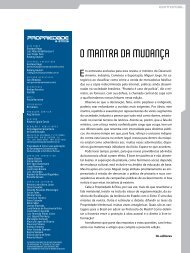Clique aqui e acesse o site - Insight
Clique aqui e acesse o site - Insight
Clique aqui e acesse o site - Insight
You also want an ePaper? Increase the reach of your titles
YUMPU automatically turns print PDFs into web optimized ePapers that Google loves.
inTroduCTion<br />
as some millefiori, made out of ouraline (a crystal incorporating uranium<br />
oxide) and in sizes as diverse as a finial just 10 cm tall and another un-<br />
common piece that is 25 cm in height (without taking into account their<br />
bronze bases).<br />
But how did such an object come into existence, a crystal sphere encrusted<br />
with colored motifs that became a virtual technical miracle and a big suc-<br />
cess in terms of decoration? It was Louis-Joseph Maës, of the Clichy crystal<br />
company, who introduced the new vogue in the middle of the 19 th century.<br />
Public records, however, lead us to 1494, in the city of Murano, in Italy.<br />
The Venetian writer Sabellio mentions a master glassmaker “who was the<br />
first to have the idea of putting inside a sphere all types of flowers pres-<br />
ent in the fields at springtime.” It is known that the motifs in millefiori, or<br />
mille-fleurs, already were being used in antiquity and the technique was<br />
known as glass mosaic.<br />
The decorated balls began to be produced by master glass blowers in<br />
Murano around the 16 th century using a method that they knew very well.<br />
Therefore, they already were exceptionally well made even before the years<br />
of their splendor, as of 1840. And the millefiori, or murrines, as Italians call<br />
them, adorned a number of objects manufactured in Venice as of the 15 th<br />
century, such as cups, bottles and knife hilts.<br />
Paperweights in glass or crystal containing polychromic inclusions were<br />
not produced beyond the 19 th century. The event that led to their appear-<br />
ance in France is interesting. Eugène Péligot, professor at the Arts and<br />
Crafts Conservatory and a delegate of the Paris Chamber of Commerce<br />
during a visit to an exhibition of Austrian industrial products in 1845 in<br />
Vienna, prepared a report about the section set aside for glass, which<br />
displayed products from Bohemia and Venice. On the occasion, one of<br />
the main exhibitors, M. Pietro Bigaglia from Venice, presented “a round<br />
paperweight made of very transparent glass, in which there was a quantity<br />
of small colored tubes and various different forms that produced an effect<br />
of a field of flowers.”<br />
It could not have been a more propitious moment for the introduction<br />
in France of these new decorative objects. In an economically troubled<br />
time, demand for large crystal pieces destined for moneyed clients was<br />
reduced and difficult to sell. Only an attractive product with a lower price<br />
could seduce a wider clientele. Moreover, access by the middle class to an<br />
education and, consequently, writing (the steel pen, invented in England<br />
in 1780, made its commercial appearance around 1830) together with the<br />
12<br />
Some types<br />
of finials<br />
(illustrations from the<br />
“Boules D’ Escalier” catalogue,<br />
by C. Deselle Fils)









